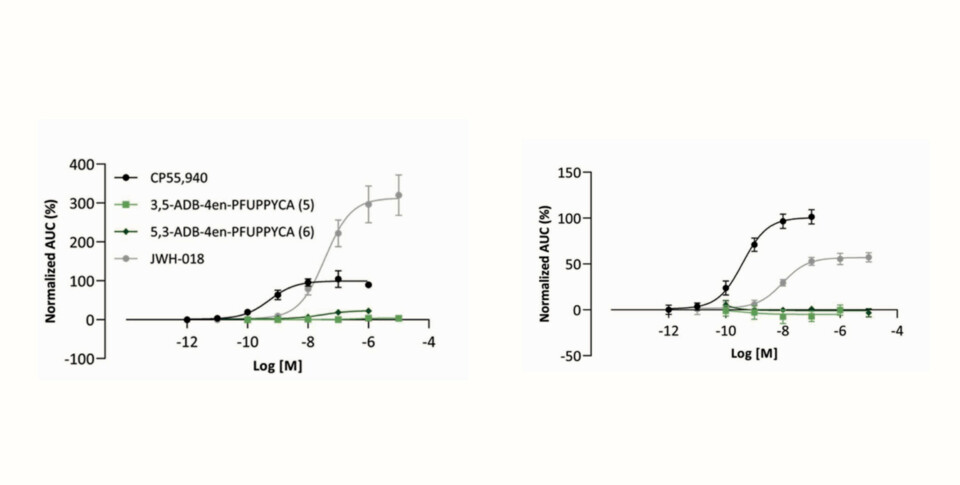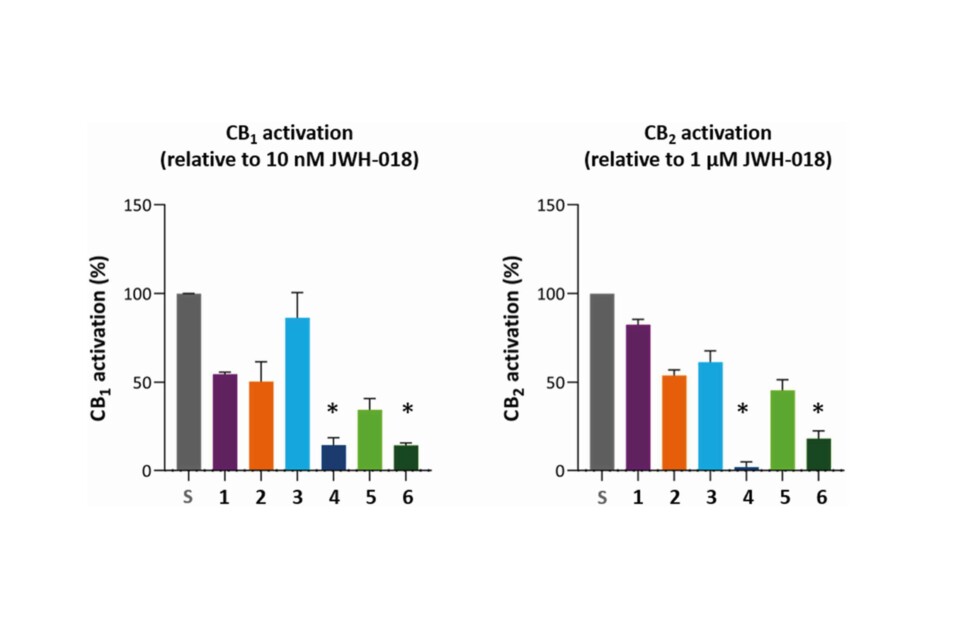
Synthetic Cannabinoids: How Dangerous Are New Derivatives?
New synthetic cannabinoids are flooding the market to bypass bans — but many act very differently from classic cannabis compounds. Recent research shows low activity at CB1 and CB2 receptors but unexpected reports of hallucinations and strange side effects. Learn why these new derivatives pose hidden risks and why their use is strongly discouraged.
Updated: June 2025
Author: Dr. Felix Blei, PhD in Microbiology, Miraculix
New Synthetic Cannabinoids — How Dangerous Are They for Weed Users?
The synthetic cannabinoid market is changing rapidly since China — the main producer and exporter — enforced a class-wide ban on all synthetic cannabinoid receptor agonists in 2021.
To bypass these stricter regulations, manufacturers have created a range of new synthetic derivatives, which are already appearing in recreational weed products. Some of these new substances were first detected as early as 2015 but have gained fresh popularity since the ban.
Chemically, this new group is mainly classified as monocyclic pyrazoles with a distinctive PFUPPYCA structure — setting them apart from older synthetic cannabinoids used to spike fake weed.

Unique Receptor Behavior of New Synthetic Cannabinoids in Weed
What’s unusual about these new synthetic cannabinoids found in weed is their unexpected receptor behavior. Unlike classic cannabinoids, these new derivatives show no activity at the CB1 and CB2 receptors. Instead, all tested compounds act as antagonists, probably because they structurally resemble known cannabinoid antagonists and inverse agonists. This unique mechanism makes them different from older synthetic chemicals sprayed on fake weed.
Key points:
- No CB1/CB2 activity: They don’t activate receptors like THC does.
- Act as antagonists: They block or reverse normal cannabinoid effects.
- Potential hidden effects: Unusual structure may cause unpredictable side effects in weed users.
How Dangerous Are These New Synthetic Cannabinoids?
So, how dangerous are these new synthetic cannabinoids?
According to Deventer et al. (2023), these new compounds show low potency and weak efficacy at both CB1 and CB2 receptors, indicating a low acute risk to public health under controlled lab conditions.
However, recent warnings — especially from drug-checking services in Germany — report hallucinations and severe side effects that cannot be fully explained by receptor antagonism alone. This suggests that unknown mechanisms of action may exist.
👉 Therefore, using products containing untested synthetic cannabinoids is strongly discouraged.
Key points:
- Low CB1/CB2 activity: Weak receptor binding confirmed in vitro.
- Unpredictable effects: Hallucinations and unusual side effects observed.
- Avoid use: Consumption of unverified synthetic cannabinoids poses unknown health risks.


How to Test THC and CBD in Cannabis – The Easy Way
Want to know if your weed really contains natural THC or if it might be spiked with synthetic cannabinoids? The THC/CBD QTest® lets you check your cannabis flower’s true cannabinoid content at home — with lab-like accuracy.
This quick test measures the total THC and CBD levels, helping you spot suspiciously low THC content, which can be a red flag for sprayed synthetic chemicals instead of real cannabinoids. Whether you’re cautious, comparing strains, or verifying a dealer’s claim, the QTest is your best tool to detect fake weed and avoid unexpected effects.
👉 Learn how to check your cannabis safely with the THC/CBD QTest®
FAQ Synthetic cannabinoids
Synthetic cannabinoids are human-made chemicals designed to mimic the effects of THC, the main psychoactive compound in cannabis. Unlike natural cannabis, these chemicals are often sprayed onto dried plant material or sold as liquids for vaping.
The term “synthetic marijuana” is misleading. Although synthetic cannabinoids activate the same receptors in the brain as THC, their effects can be far stronger, less predictable, and far more dangerous.
Most people smoke synthetic cannabinoids by rolling the sprayed plant material into cigarettes, pipes, or joints. They can also be vaped using liquids in e-cigarettes.
Synthetic cannabinoids are sold under many names, including Spice, K2, Black Mamba, Scooby Snax, Joker, Kush, and Blaze. New brands appear constantly to avoid legal restrictions.
Many synthetic cannabinoids are illegal in numerous countries, including the US, UK, and EU. However, manufacturers frequently alter the chemical formulas to create new versions that temporarily evade bans.
They can cause severe health effects such as rapid heartbeat, high blood pressure, hallucinations, paranoia, violent behavior, kidney damage, and even death. Unlike cannabis, overdoses can be life-threatening.
Some use them because they are cheap, easy to obtain, and sometimes undetectable in standard drug tests. They’re also sometimes used by individuals who want to avoid legal penalties for cannabis.
Yes. Many users develop cravings and withdrawal symptoms, and repeated use can lead to addiction, with more severe withdrawal than cannabis.
It’s nearly impossible without proper testing. Some fake cannabis, CBD, vape liquids, or herbal incense may secretly contain synthetic cannabinoids. Reagent tests or lab analysis are the only reliable ways to check.
Call emergency services immediately. Synthetic cannabinoids can cause dangerous side effects very quickly — prompt medical help can save lives.
AUTHOR PROFILE
Dr. Felix Blei – Scientific Author
Dr. Felix Blei is the CEO and Founder of miraculix Lab, and a Postdoctoral Researcher at the Friedrich Schiller University Jena. With a PhD (Dr. rer. nat.) in Microbiology and a strong background in natural product biosynthesis, he is internationally recognized for his pioneering work on psychoactive fungi—particularly the biosynthesis of psilocybin and related compounds (Blei, F., 2020).
During his doctoral research at the Institute of Pharmaceutical Microbiology under Prof. Dirk Hoffmeister, Dr. Blei was the first to elucidate the full biosynthetic pathway of psilocybin in Psilocybe mushrooms (Fricke, Blei et al., 2017) Angewandte Chemie. He further developed an in vitro system capable of producing psilocybin, serotonin, and novel non-natural analogues (Blei et al., 2018) Chemistry- A European Journal . His discovery of naturally occurring β-carbolines in Psilocybe—compounds that may synergistically enhance psilocybin's neurotropic effects—led to the concept of “psilohuasca,” a naturally occurring combination of MAO inhibitors and psychedelics in fungi (Blei, Dörner et al. 2020) Chemistry–A European Journal.
Building on his academic expertise, Dr. Blei developed the first reliable rapid tests for psilocybin, which laid the foundation for the spin-off company miraculix. Today, miraculix provides quantitative drug checking tools that are used throughout Germany and Europe. He also leads the German ALIVE project—an evidence-based drug checking Initiative funded by state governments, offering mobile substance analysis and harm reduction at music festivals and public events.
With over 500 citations, numerous publications in high-impact journals, and a passion for accessible science, Dr. Blei bridges cutting-edge research with real-world application. His work contributes to safer substance use, public health strategies, and a deeper understanding of natural psychoactive compounds.
You can learn more about him on LinkedIn or read his publications on Researchgate



